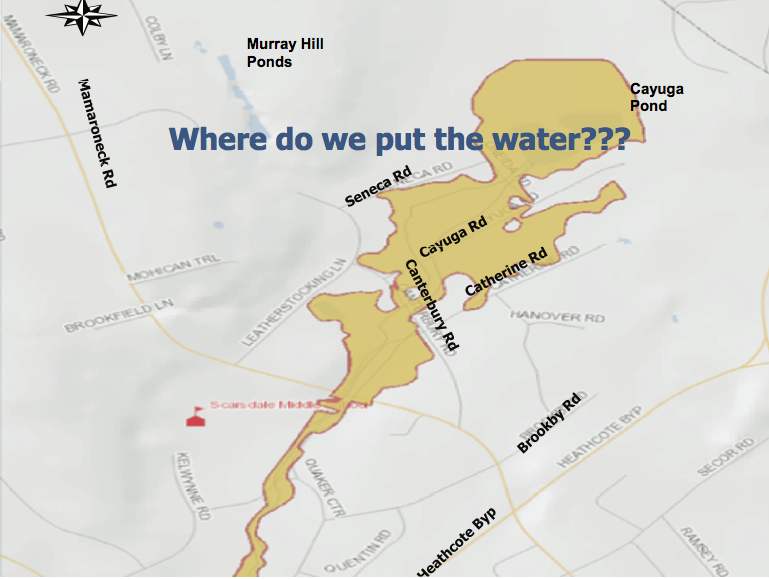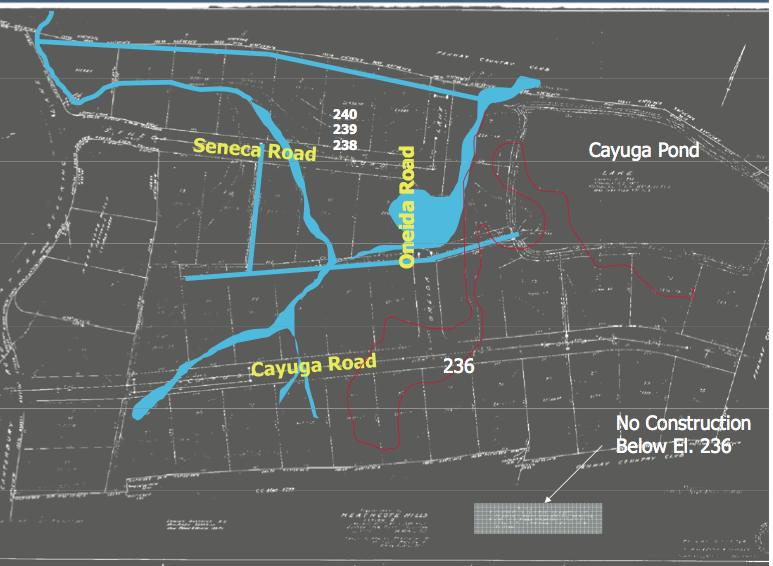Engineers Explore Options to Alleviate Flooding Around Cayuga Pond
- Monday, 04 June 2012 17:45
- Last Updated: Tuesday, 05 June 2012 08:31
- Published: Monday, 04 June 2012 17:45
- Hits: 5866
 The village is still looking for a solution to the periodic flooding in the area bordered by Oneida, Seneca and Cayuga Roads, which peaked in 2007 and again during Hurricane Irene in August, 2011. After Hurricane Irene, a Cayuga Road resident with a pool found water rushing into his basement and fish swimming in his pool. In response to complaints from homeowners, Scarsdale Village has retained engineers Dvirka and Barticlucci of White Plains to do an analysis of the problem and recommend solutions. The firm came before the Municipal Services Committee and concerned residents on May 31 to share their findings and explore options.
The village is still looking for a solution to the periodic flooding in the area bordered by Oneida, Seneca and Cayuga Roads, which peaked in 2007 and again during Hurricane Irene in August, 2011. After Hurricane Irene, a Cayuga Road resident with a pool found water rushing into his basement and fish swimming in his pool. In response to complaints from homeowners, Scarsdale Village has retained engineers Dvirka and Barticlucci of White Plains to do an analysis of the problem and recommend solutions. The firm came before the Municipal Services Committee and concerned residents on May 31 to share their findings and explore options.
The problem is easy to understand. Homes in the affected area are built on a FEMA designated flood plain flood plain and previous to the construction of the development in 1960, this area served as a drainage basin. Since the entire area is flat and has a high water table, there is no slope to move water away -- and it’s not possible to dig deep retention basins as the water table is too high.
Engineers came up with two options for improving, but not completely alleviating the flooding using dry detention underground with infiltration and moving the water away from the site using pumps or gravity. According to the engineers’ simulations, using dry detention in the two ponds they could alleviate flooding from a “2 year” storm, meaning one where 3.5 inches of rain falls in 24 hours. However, for volumes above that, there would still be flooding in the area. For instance, in a 100-year storm like Hurricane Irene, 7.5 inches of rain fell in a 24-hour period and the recommended plan would not avoid flooding in extreme storms.
To start, the firm recommends that two ponds in the area, Murray Hill Pond and Cayuga Pond be converted into true storm water detention  ponds. They currently provide no storm water attenuation. They recommend the removal of 6 to 12 inches of silt from Cayuga Pond, and removal of debris and sediment in Murray Hill Pond. They also suggest that the storm water piping be rehabilitated to improve conveyance. The approximate cost for the above is estimated to be at $1.6 to $2 million.
ponds. They currently provide no storm water attenuation. They recommend the removal of 6 to 12 inches of silt from Cayuga Pond, and removal of debris and sediment in Murray Hill Pond. They also suggest that the storm water piping be rehabilitated to improve conveyance. The approximate cost for the above is estimated to be at $1.6 to $2 million.
As an extra measure, to keep homes dry in more severe storms, the engineers recommended building underground storage detention in private yards or pumping the water away from the site to underground retention basins that could be built at the Scarsdale Middle School. This option is far more costly and requires the construction of detention basins under the playing fields at the school.
In a discussion following the presentation residents made other suggestions about what could be done.
One suggested building up the ground around Cayuga Pond in a berm to block the water from flowing out. Another wanted to widen the existing culvert to accommodate more water – though the engineers were doubtful that this would work as the area is flat. For a larger detention basin more land area was needed and the engineers did discuss storing it on the golf course that surrounds the development – however cooperation would be needed.
At the conclusion of the meeting, Trustee Kay Eisenman who chairs the Municipal Services Committee told the group that the “staff would look at all the comments they heard, spend two or three weeks evaluating them and then come forward with what they think can or cannot be done.”
Following the meeting residents discussed yet another option – proposing that Scarsdale Village purchase three homes in the area that are prone to flooding. The homes could be taken down and the property used for water retention. However this would be a costly undertaking for the village as it would need to pay for the homes and lose ongoing real estate tax revenues. This idea may be more wishful thinking on the part of homeowners than a workable solution for Scarsdale. It was evident at the meeting that homeowners are anxious for decisions to be made and work to begin to safeguard their homes before another "ten year" storm occurs.










